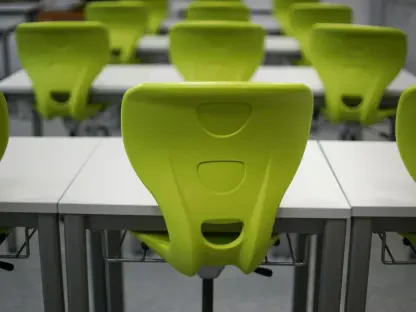In Massachusetts, a legislative proposal seeks to address the growing concern over the impact of cellphones on students by implementing a comprehensive “bell-to-bell” ban on their use in public K-12 schools. Spearheaded by Governor Maura Healey, this initiative has garnered backing from prominent figures such as Attorney General Andrea Campbell and Senate President Karen Spilka. The driving force behind the proposal is the mounting evidence suggesting that unrestricted cellphone access during school hours undermines students’ ability to concentrate and fully engage in their education. Advocates argue that the ubiquitous presence of these devices in schools is contributing to a decline in academic performance, social interaction, and overall mental well-being. The proposed legislation, therefore, aims to foster a more focused and supportive learning environment. Whether this ban is an appropriate response to the challenges posed by digital distractions is a matter of ongoing debate, reflecting a larger trend nationwide toward regulating technology use in educational settings.
Distraction-Free Learning Environments
The aspiration to create a distraction-free learning environment stands at the heart of the proposed cellphone ban in Massachusetts schools. Proponents of the legislation argue that the academic environment is significantly compromised by the omnipresence of cellphones, which not only distract students but also hinder meaningful interaction with peers and educators. Studies have shown a correlation between device usage and diminished classroom engagement, leading to poorer academic outcomes. The argument is further supported by educators who report that cellphones interrupt teaching and learning processes, limiting exchanges that are essential for critical thinking development and personal growth.
The proposed legislation aims to address these educational concerns by strictly limiting cellphone use during school hours, which proponents argue would lead to notable improvements in students’ academic performance and engagement. By eliminating a major source of distraction, it is hoped that students will be better able to focus on instruction and collaborative activities integral to the educational process. Echoing a broader movement across various states to moderate technology’s role in scholastic environments, the Massachusetts initiative reflects a growing awareness of the need to recalibrate the balance between digital convenience and pedagogical efficacy. Still, critics question whether such measures presume an oversimplification of technology’s role, suggesting that educational strategies might better incorporate responsible digital use.
Addressing Mental Health Concerns
A significant rationale behind the legislative push for a cellphone ban in schools is the concern over student mental health. Increasingly, research has highlighted links between excessive cellphone use and rising levels of anxiety, depression, and other psychological issues among adolescents. Constant connectivity through social media has been linked to feelings of inadequacy, social pressures, and cyberbullying, which can exacerbate mental health challenges. The legislation aims to protect students from these detrimental effects, promoting a healthier, more balanced school experience that prioritizes mental well-being alongside academic achievement.
Mental health advocates supporting the ban argue that schools have a responsibility to create safe and nurturing environments where students can thrive emotionally and intellectually. By removing the pressure to remain constantly connected, the ban could alleviate some of the stressors associated with digital communication. However, there are voices of opposition concerned that an outright ban might ignore the nuances of technology’s influence and fail to empower students with the skills needed to manage their digital lives responsibly. This highlights a critical consideration in the debate: how best to prepare students for a world where digital literacy is imperative while safeguarding their mental health.
Balancing Parental Communication Needs
Another pivotal aspect of the proposed cellphone ban is how it addresses concerns related to parental communication with their children during school hours. Governor Healey has emphasized that while the ban seeks to eliminate distractions, it must also consider and provide for circumstances where students need to be reachable by their parents, especially in emergencies. It is critical to maintain communication channels that ensure peace of mind for both parents and students, recognizing that modern technology plays an integral role in family connectivity and safety.
The legislative proposal incorporates provisions for exceptions, allowing for communication in specific, justified cases or emergencies. This flexibility is designed to reassure parents that their ability to contact their children when necessary will not be unduly hindered. Moreover, the bill proposes that schools implement strategies tailored to maintaining essential communication without compromising the overarching goal of reduced disruptions. These measures highlight the delicate balancing act policymakers face in addressing concerns around both engagement and accessibility, underscoring the complexity of crafting legislation that satisfies diverse stakeholder needs while attempting to enhance the educational atmosphere.
Implementation Challenges and Flexibility
Determining the most effective way to implement a cellphone ban in schools poses various challenges, particularly regarding the balance between statewide uniformity and the flexibility needed to respect individual district needs. The proposed legislation in Massachusetts allows for certain exceptions, such as cellphone use for students with disabilities, during emergencies, or when devices are critical for health and safety. By doing so, it seeks to cater to the diverse requirements of students while maintaining its directive to limit distractions.
Local educational leaders are anticipated to play a crucial role in developing specific implementation strategies that align with the statewide policy but are adaptable to the unique circumstances of their districts. The legislation’s flexibility is intended to afford administrators the latitude to address unforeseen challenges and ensure effective integration into school systems. This approach seeks to strike a balance that accommodates varying educational environments and needs, aiming to create a consistent framework across the state that fosters improved educational and mental health outcomes. However, the diversity of implementation may itself pose challenges in tracking effectiveness and ensuring accountability across differing district strategies.
Nationwide Trends and Consensus
Following national trends, Massachusetts’ proposed ban on cellphone use in schools aligns with legislative actions seen across approximately half of the United States. This convergence reflects an escalating concern with technology’s unchecked influence on youth development and well-being. Regions that have enacted similar laws or recommendations typically cite improved academic outcomes and overall school environment as a result of enforcing stricter controls on cellphone usage. The Massachusetts initiative also parallels this trend, backed by a consensus among supporters that limiting digital distractions can lead to healthier educational settings and enhanced student focus.
This legislative motion echoes growing parent and educator apprehension over the potential negative impacts of digital technology and social media on developing minds. As these concerns have gained traction, they have prompted a shift toward more regulated technology usage in academic environments across the country. By aligning with this consensus and reinforcing a cultural movement to moderate technology’s educational impact, Massachusetts lawmakers are joining a broader discourse about redefining the place of digital devices in daily school life. However, discussion continues about the unintended consequences of such regulations and the importance of equipping students with critical digital management skills.
The Path Forward
A new legislative proposal in Massachusetts seeks to address concerns over cellphones’ impact on students by introducing a sweeping “bell-to-bell” ban in public K-12 schools. This initiative, led by Governor Maura Healey, has received support from key figures such as Attorney General Andrea Campbell and Senate President Karen Spilka. The proposal hinges on growing evidence suggesting that unrestricted cellphone access during school hours detracts from students’ concentration and engagement in their educational pursuits. Critics argue that the constant presence of these devices has led to a drop in academic performance, diminished social interactions, and decreased mental well-being. Consequently, the proposed legislation aims to cultivate a more focused, supportive educational environment. The debate over whether a total ban is the ideal solution to digital distractions continues, mirroring a broader movement across the nation that seeks to regulate technology use within schools to improve education quality.









